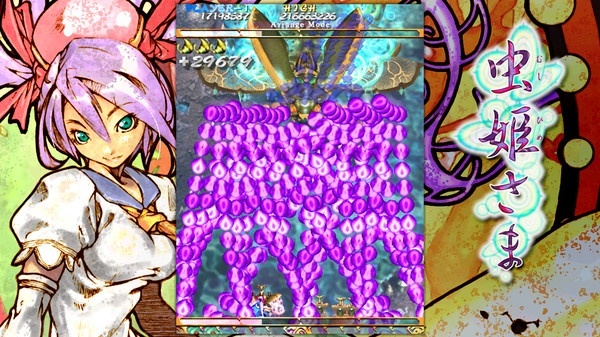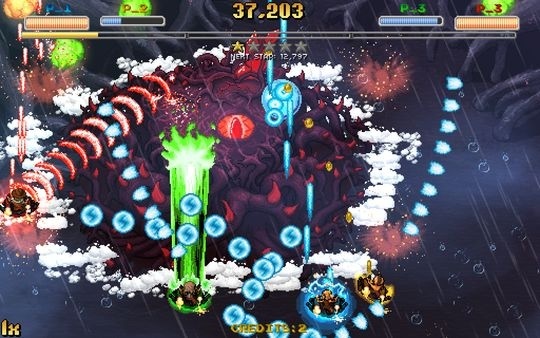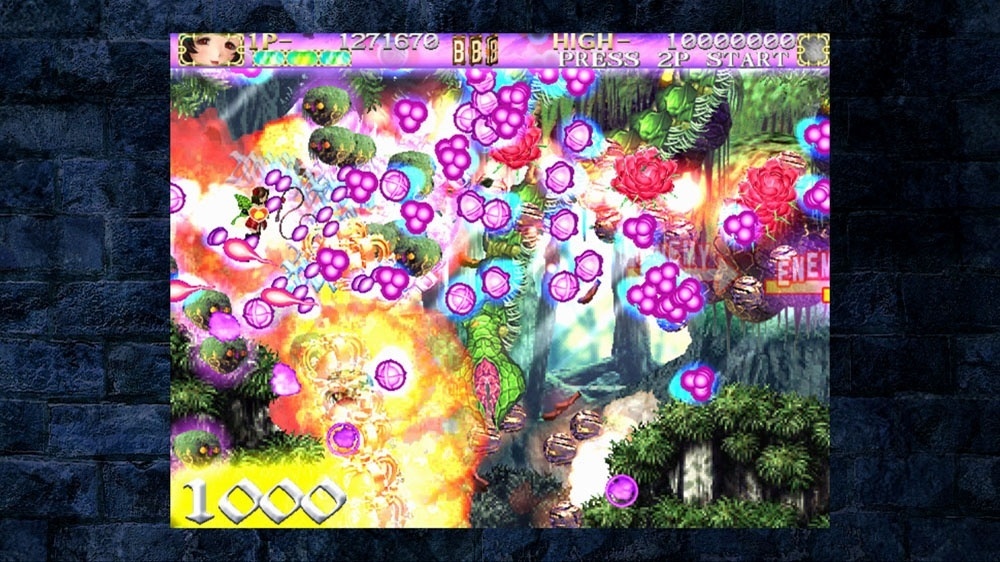The 2D shooting game (aka shoot 'em up, aka shmup, aka STG) is one of the oldest genres in video games. Space Invaders simultaneously kick-started the genre while launching the video arcade revolution as a worldwide phenomenon. This game set the template for the genre - a ship at the bottom of the screen exchanging shots with formations of enemies at the top. Three lives. High scores. The ruleset sketched out by Space Invaders has remained in place for decades and is still part of the DNA of its offspring.
As arcade quality graphics moved into the home and the mainstream fell in love with games set in 3D worlds, the market for 2D shooters eroded steadily, but it has enjoyed a recent mini-revolution of sorts—the charge being led in the main by small Japanese developers initially supporting arcade cabinet releases, before progressing to mainstream consoles, the Steam platform, and mobile devices—and the genre has developed quite a bit from its simple and pure origins.
Modern shmups ain't your daddy's Space Invaders. They are a sensory overload with the screen constantly filled with explosions and colourful enemies and bullets to the point where the game appears extremely abstract and possibly quite mindless to the uninitiated. They also certainly appear intimidating and many will be—in all likelihood—put off even trying to play.

Bullets.
There are lots of bullets in modern shmups. What started as a sub-genre, called "bullet hell," first appearing in the late 90s, has become the prevalent style of game. The main feature is complex patterns of bullets that in some cases have a strange hypnotic beauty that are to be navigated through, their denseness and ubiquity meaning that background graphics are quite often obscured.
The player's on-screen representative is equipped with screen-filling fire power, too—it's as if the genre has reached the end of an imaginary arms race with both sides utilising the theoretical pinnacle of weapons technology.
Uninformed reviewers claim such games are impossible, but this simply isn't true. I am afraid that they may have spent their allocated playtime by playing a few games and using the continue option when they ran out lives until they reached the end. Most modern games allow you to continue in this fashion, and given the small number of levels they have, the reviewer will mistakenly think that they have seen everything the game has to offer and consider it and its genre to be short-lived, pointless and boring. Playing these games that way is boring, and I often wonder why game devs allow it to happen because it simply isn't the right way to play them.

Modern shoot 'em ups are meant to be played and replayed until you can complete them without having to resort to using the continue option. In old-fashioned arcade terms, this means completing the game using just one coin—or 1 credit. The one credit completion, or 1CC, is the primary challenge that these games set the player.
To be fair to modern mainstream reviewers, many perhaps haven't any experience of arcades in their prime, and thus are not familiar with the notion of credits and the focus older arcade games had on high scores. Not having arcade sensibilities and trying to review such a game on a time budget, a 1CC looks to be impossible, but there are a number of gameplay features that make it quite possible. Not easy—but most certainly not impossible.
First of all, there is the idea of small collision boxes. The collision box is that part of the ship or character that a bullet must hit in order for it to register. This means that bullets can in fact hit you without causing a life loss. The collision boxes in modern games are usually very small—only a few pixels in size, and in some extreme examples only one pixel. The collision box is usually also coloured differently for easy identification and quite often will glow in order to aid the player. This enables some heroic looking manoeuvres, with the player squeezing through what look like impossibly tight gaps—becoming adept at this is one of the joys of modern STG playing. If one were to take the time to watch some expert playthroughs of these games on YouTube, you will see that, more often than not, highly skilled players barely need to move their ship at all while navigating through dense bullet clouds. A vital skill required of these games is the ability to focus on the area around your ship, spotting the narrow paths through the bullet clouds to safety.

The concept of a "smart bomb" (usually just referred to as a bomb) has been in shooting games since its earliest days. The player will have a limited reserve of bombs, and activating one is like using a get-out-of-jail-free card, as it typically destroys all of the bullets on the screen, and will either destroy all enemies or at least cause a great deal of damage to them. These are typically used in situations of great peril when the player can see no way of escaping an impending collision with an enemy bullet. Some expert players will try and get through an entire game without using these, and the better games are designed so that this can be done—and often, there is a scoring bonus for minimising or avoiding the use of bombs.
You don't always have to use a bomb to get rid of bullets, though, because there is a feature called "bullet cancelling." Some games have a rule implemented that means when certain larger enemies are defeated and explode, they destroy all of the bullets on screen, as well. This means that players can plan routes through the level that involve becoming deliberately surrounded by bullets with little chance of escape, while concentrating fire on one particular enemy, which, when destroyed, clears the screen. The better games are often designed to create these scenarios in such a way that the targeted enemy is defeated just before the player is overrun by a cloud of bullets, which is a highly enjoyable experience requiring nerves of steel and focused concentration. Some games turn cancelled bullets into tokens that can be picked up for extra points, and this is a feature that skilled players will try and take advantage of.

Some bullets in modern shooting games are fired in pre-set patterns, presenting a maze through which the player must navigate, while others are aimed at the player. Aimed bullets can be manipulated by skilled players who use a technique called "tap dodging," which is essentially a series of small regular movements to the left or right. When this is properly executed against a barrage of aimed shots, it is extremely effective, as the bullets are always aimed at where the player was, and when used effectively, it can take a long time to reach the edge of the screen, all the while safe from aimed shots, before a skilful reversal (sometimes called a cutback) is needed, or if the opportunity is presented, bullet cancelling is used.
There was a time when hardware limitations resulted in games that would suffer what is called slowdown. This is an effect that is experienced when the processor cannot perform the calculations associated with all the objects on screen at the desired framerate. Modern hardware can now move so many objects around the screen that slowdown can technically been eliminated from the shooting game genre. However, it often remains a gameplay feature. Developers implement slowdown as a reward to the player if they can prevent a collision until a set number of objects (bullets) is being displayed, at which point slowdown activates, making bullet navigation easier. This deliberate slowdown is a further aid to players in navigating through particularly difficult parts of a level, and can boost a score if bullets cancelling into bonus items is a part of the game.

Quite often, a shmup will steadily increase in difficulty with each successfully completed level. However, many games also increase difficulty depending on how well the player is doing. The player's score, lives remaining or level of weapons obtained can, in certain cases, cause the game to increase in difficulty very quickly. This is the concept of a game's rank, and certain games can have their rank managed by, in some cases, adopting severe strategies, such as deliberately losing a life, or perhaps ignoring power-ups that may arm the player with heavier artillery.
These gameplay features are now prevalent in many modern shooting games, and together they offer opportunities for skilful play and pretty impressive looking gameplay, which can be intimidating to the onlooker. They also make modern shooting games, with their dense patterns of bullets and enemies, possible to complete with a limited number of lives without using the continue option. Completing a game without using continues is a challenge to the player, and quite often there are rewards for doing this.

First of all, there is the concept of the high score. A very old-fashioned idea nowadays that perhaps is one of the main reasons the shooting game genre is so out of vogue. Scoring well is important, since most games will award extra lives for attaining certain scores. More importantly, though, selecting continue will reset the player's score to zero. Some games will retain the score, but will add 1 point to the score, which, in a scoring scheme typically made up of multiples of 10 and above, shows to an informed observer that the player has continued.
Then there is the idea of reaching a game's "true ending." Some games will grant access to a final secret level of the game, which is only accessible by players who have reached the fake end of the game without continuing. There are other games that unlock a second playthrough of the entire game again, with the difficulty increased significantly, provided certain goals (such as a certain score) have been attained, called in shooter circles the "second loop," and are for true masters of the game. These games are only truly completed when both loops are completed without continuing. One famous title, DoDonPachi, which is one of the earliest examples of the modern shoot 'em up, presents the player with a final true boss at the end of the second loop. Second loops are usually incredibly difficult to complete, taking many months or longer to master.

When a game's ending is reached, quite often the player will also receive a bonus for any lives and bombs left over at the true end of the game, and these bonuses can make a significant difference to the final score.
Managing a 1CC is, for some players, only the beginning of the story, though. The better examples of the genre have very clever scoring rules and bonuses. This means that shooting games have a duality within their design. At one level they can be played for what is called "survival," meaning doing whatever is necessary to reach the end of the game on one credit. Quite often this means using bombs more frequently, but it also usually means forgoing attempts for high scoring bonuses because they are gained only by players prepared to take risks. The idea of balancing risk and reward is embedded into shooting games, and once a player has achieved the goal of playing for survival, then the dedicated players start playing for score, which is when shooting games really start to offer value for money and show themselves as the intelligent games they are—a far cry from the seemingly mindless and impossible challenge they appear to be to the uninitiated.
Modern shooting games, when played for score by manipulating their complex and interrelated rules, reward the player with scores that are orders of magnitude higher than scores attained by those who play for survival, and there is a healthy online community that shares scoring tricks and strategies, as well as their high scores.

However, even that isn't all that modern shooting games have to offer. Most have a selection of ships or characters with which to play that have differing strengths and weaknesses, and each of those sometimes has further configuration options introducing more differences. Once a player has become familiar with the game, playing it with a different character variation will make it feel significantly different. It can be a delight to discover an option that makes a particularly tricky section easier to deal with, but it often comes at a price of finding another section or sections more difficult—such is the delicate and clever balance this genre of game offers up.
In summary, then, modern 2D shooting games are a genre that requires a high level of skill, practice and concentration from the player. These games are short. A successful playthrough might last around 20 to 30 minutes. This is simply because the level of intensity of these games is such that the demands placed on the player mean that they couldn't be longer, though.
There is a certain level of learning by rote with these games, and perhaps that puts some off. They demand a level of intelligence, too, though—finding successful navigation patterns and figuring out the scoring systems (which are usually not fully documented in the game manual) requires a considerable amount of mental effort. This mix of visceral mayhem, considered risk taking and score system manipulation adds up to an experience I don't believe can be gained from any other genre, and modern gamers who haven't spent any time with a modern shmup really owe it to themselves to put that right.


 Sign In
Sign In 03.09.2016
03.09.2016  Azuardo
Azuardo 
 Link to this post:
Link to this post:  jesusraz
jesusraz  Subscribe to this topic
Subscribe to this topic Features
Features





 Top
Top

